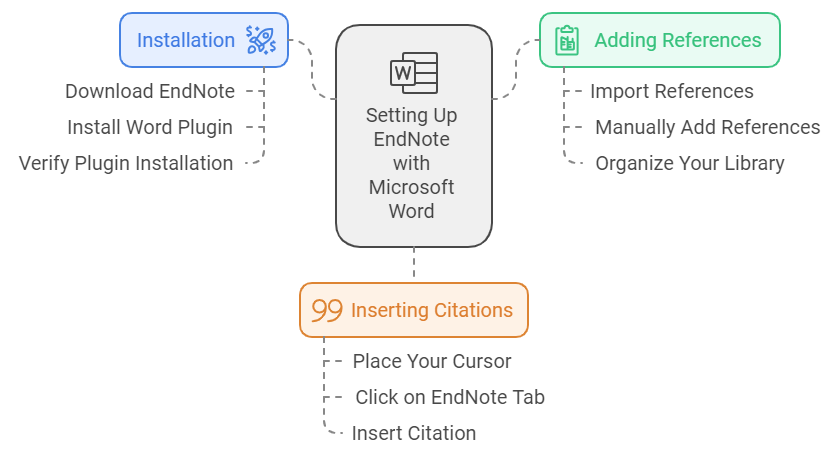Last Updated: January 24, 2025
Do you dread the task of managing citations when working on your research papers or academic projects in Microsoft Word? You’re not alone! Many students, researchers, and professionals struggle with citation management, but integrating EndNote with Microsoft Word can make it much easier. In this blog post, we’ll explore how you can seamlessly connect EndNote with Word, allowing you to create, format, and organize references effortlessly. Let’s dive in!
Table Of Contents
- 1 Why Integrate Microsoft Word with EndNote?
- 2 How to Set Up EndNote with Microsoft Word
- 3 Creating a Bibliography in Microsoft Word with EndNote
- 4 Frequently Asked Questions About Using Microsoft Word with EndNote
- 5 Key Benefits of Using EndNote with Microsoft Word
- 6 Tips for a Successful Integration
- 7 Conclusion
Why Integrate Microsoft Word with EndNote?
Integrating Microsoft Word with EndNote can significantly enhance your writing workflow, especially if you work on research-heavy documents. EndNote is a powerful reference management software that allows you to collect, store, and organize your research references. By integrating it with Word, you can streamline the process of citing sources and generating bibliographies directly within your document.
Here are some compelling reasons why you should consider using EndNote with Microsoft Word:
- Automate Citation Management: No more manual input! EndNote automatically formats citations according to the style you choose, such as APA, MLA, or Chicago.
- Save Time: EndNote integration means you can focus on writing instead of manually managing references, saving hours of tedious work.
- Eliminate Errors: Incorrect citations are a thing of the past—EndNote ensures all citations are properly formatted and consistent.
- Stay Organized: Easily store and organize thousands of references for future use.
How to Set Up EndNote with Microsoft Word

1. Install EndNote and Enable the Word Plugin
To start using EndNote with Microsoft Word, you need to install EndNote and make sure the plugin is activated in Word.
- Download EndNote: If you haven’t done so yet, download EndNote from EndNote’s official website. The software is available for both Windows and Mac.
- Install the Word Plugin: When you install EndNote, the Word plugin will automatically be added. This plugin is what enables the integration between EndNote and Microsoft Word.
- Verify Plugin Installation: Open Microsoft Word, and you should see an EndNote tab in the ribbon, which indicates that the plugin is active.
Pro Tip: If you don’t see the EndNote tab, you may need to reinstall the plugin or manually enable it from the Word Add-ins settings.
2. Adding References to EndNote
Before you start adding citations to your Word document, you need to add your references to EndNote.
- Import References: You can import references directly from databases like PubMed, Google Scholar, or Web of Science. Just look for the export to EndNote option.
- Manually Add References: You can also manually add references by clicking on “New Reference” and filling in the necessary bibliographic information.
- Organize Your Library: Use groups and tags to organize your references for easy access.
3. Inserting Citations in Microsoft Word
Inserting citations into your Word document using EndNote is quick and easy:
- Place Your Cursor: Position your cursor where you want to add the citation.
- Click on the EndNote Tab: In Word, click on the EndNote tab in the ribbon.
- Insert Citation: Click “Insert Citation”, and search for the reference you want to add. Once selected, the citation will be automatically inserted in the correct format.
Bonus Tip: You can select the citation style you want by clicking on “Style” in the EndNote tab and choosing from a wide range of options, such as APA, Chicago, Harvard, and more.
Creating a Bibliography in Microsoft Word with EndNote
Generating a bibliography has never been easier. Here’s how to do it:
1. Insert Citations: As you insert citations throughout your document, EndNote will automatically generate a bibliography.
2. Format the Bibliography: To format or update the bibliography, simply click on the EndNote tab and select “Update Citations and Bibliography”.
3. Change Styles: If you need to change the citation style, it’s as simple as selecting a new style from the “Style” dropdown menu.
The bibliography will be instantly updated to match the selected style, saving you a ton of manual formatting time.
Frequently Asked Questions About Using Microsoft Word with EndNote
1. Is EndNote free to use?
EndNote offers a free basic version, but the full-featured version requires a subscription or a one-time purchase.
2. Can I switch citation styles after inserting citations?
Yes! You can easily change citation styles in Microsoft Word by selecting a different style from the EndNote tab.
3. Does EndNote work with both Mac and Windows?
Yes, EndNote is compatible with both Mac and Windows systems, and it works with the corresponding versions of Microsoft Word.
4. Can I use EndNote for collaborative projects?
Absolutely! EndNote allows you to share references with other users, making it easy to collaborate on group research projects.
5. How do I fix missing citations in Word?
If a citation is missing, make sure the EndNote library is open and the reference is in the correct group. You can then re-insert the citation using the Insert Citation option.
Key Benefits of Using EndNote with Microsoft Word
– Time Savings: No more hours spent formatting citations manually—EndNote handles it for you.
– Professional Results: Generate properly formatted, professional-grade bibliographies with just a few clicks.
– Versatility: Easily switch between different citation styles depending on journal or publisher requirements.
Tips for a Successful Integration
- Organize Your Library Early: Organize your references as you add them, making it easier to find what you need when writing.
- Backup Your Library: Always keep a backup of your EndNote library to prevent data loss.
- Use Groups: Create groups in EndNote for each project or paper to easily keep track of relevant references.
Conclusion
Integrating Microsoft Word with EndNote is a must for anyone who regularly works with research papers or documents that require extensive referencing. This integration streamlines the process of adding citations, creating bibliographies, and ensuring that everything is properly formatted. Whether you’re a student, researcher, or academic professional, EndNote can save you valuable time and help you avoid the headaches of manual citation management.
Start using EndNote with Microsoft Word today and experience the difference it can make in your writing process. With just a few clicks, you can ensure that your references are always correct, complete, and ready for submission.




